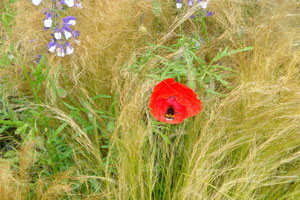Encouraging wildlife into your garden
 We welcome Mr McGregor, an avid gardener and writer back to Reckless Gardener. Throughout his column Mr McGregor aims to share his opinions and knowledge with us, in the hope that it will encourage new ideas and get us back out into the garden.
We welcome Mr McGregor, an avid gardener and writer back to Reckless Gardener. Throughout his column Mr McGregor aims to share his opinions and knowledge with us, in the hope that it will encourage new ideas and get us back out into the garden.
Spending time in the garden is my favourite way to see the hours through. I love to see my children play outside and take an interest in what I do out there, but it fills me with joy to also share my garden with wildlife. When my children were younger they were always interested to see what species visited and loved to discover new friends.
One summer, we were actually graced by a hedgehog; as it rolled into a tight ball it was great to teach my children about the ways animals protect themselves against predators. I also remember one occasion when my children came running into the kitchen shouting about a small, soft, black creature they had seen in the garden. It was a mole. They had obviously touched the animal to know that its fur was soft, so I had to explain that not all animals, especially wild ones, are particularly fond of being handled, and can also bite quite hard.
This experience was a great way to introduce the concept of nocturnal animals to them too; I must say I was a little surprised they had encountered one in the early hours of the afternoon.
Encouraging wildlife into your garden is a great way to ensure there is always something interesting happening around you; it’s also incredibly simple. From the easiest of ways of placing bird feed tables to some of the more challenging activities, like installing a pond, you can always provide nature with a happy home.
Garden walls
Garden walls make ideal homes for a variety of wildlife. From invertebrates such as snails and wall mason wasps to butterflies and birds, walls can offer a lot to a garden. Birds are particularly fond of garden walls due to the number of tasty insects they can house. If you want flocks of birds entering your garden I’d recommend you grow a climber along your wall – they provide a great nesting site for birds. I love a good honeysuckle in the garden, they are fairly easy to take care of and attract a great buzz of wildlife. Not only does the trusty hummingbird flock to these flowers; moths and butterflies are also attracted to their smell and colour too.
Flowers
Flowers are the main ingredient for any well-worked, balanced garden. They provide colour, texture and bring the garden to life. You’ll see bees pollinating and helping to grow your borders, butterflies gracing the petals of buddleias and birds starting up home using your plants to nest their offspring. Flowers give the gardener immense joy, but even more can be taken when you see what wildlife they bring to your back garden.
If you want to attract butterflies I would recommend that you grow:
• Garden phlox
• Asclepias tuberose
• Blanket flower
• Aster novae-angiae
If you want to attract bees I would advise you grow:
• Aquilegia
• Erigeron Fleabane
• Echinops ritro Globe Thistle
• Nigella damascena Love-in-the-mist
• Papaver orientalis Oriental poppy
If you want to bring birds into your garden during the colder months I would begin growing:
• American Cranberry Viburnum
• Red-Twig Dogwood
• Chokeberry
• Wahoo
There are a lot more flowers you can plant and grow to attract butterflies, which can all be found at popular garden centres such as Notcutts.
Bird feeders and boxes.
Having a variety of bird boxes and tables is a great way to keep birds safe and provide them with healthy foods when sources are scarce. From October through to April I would recommend leaving out a selection of sunflower seeds, peanuts and wild bird seed for birds to graze on. A little tip that has worked wonders for me is to keep out fresh coconut shell – tits went mad for it. Crumbled cheese, cooked rice, raisins and bruised fruit are also popular with birds.
The placement of the table isn’t crucial, but I would keep it in a quiet location. The same goes for boxed too; keep them in safe and peaceful locations so they’re not disturbed and are out of reach from predators.
No matter how you want to encourage wildlife into your garden, it’s always great to see others enjoying the fruits of your labour. Encourage nature into your garden and watch as your children become fascinated with other animals and insects.
Photo© Reckless Gardener

